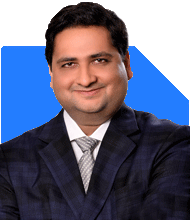Hardik Parikh | Answer |Ask -Follow
Tax, Mutual Fund Expert - Answered on Apr 07, 2023
He also holds an MBA degree from IIM-Indore.
Hardik, who began his career as an equity research analyst, founded his own advisory firm, Hardik Parikh Associates LLP, which provides a variety of financial services to clients.
He is committed to sharing his knowledge and helping others learn more about finance. He also speaks about valuation at different forums, such as study groups of the Western India Regional Council of Chartered Accountants.... more

Hi, My age is 49 years. I have been investing in NPS for last 8 years @Rs 1.5L per annum. From 2022, I have started investing in SIP for last one year, ICICI pru Business cycle fund@10 k monthly, ICICI pru midcap fund@5k monthly , ICICI pru MNC fund @10k monthly, ICICI pru small cap@10k monthly and ICICI pru overnight fund@2L lumpsum. Goal is to get 1.75 L per month at the age of 60. Am i on track?
Thank you for reaching out for financial advice. I appreciate that you have been proactive in planning for your retirement. Based on the information you've provided, here's a high-level assessment of your investment strategy and whether you are on track to achieve your goal of receiving ₹1.75 L per month at the age of 60.
National Pension System (NPS): You have been investing ₹1.5 L per annum in NPS for the last 8 years. Assuming an average annual return of 8%, by the time you reach the age of 60, your NPS corpus could be approximately ₹44 L. You can withdraw 60% of this amount as a lump sum (₹26.4 L), while the remaining 40% (₹17.6 L) will be used to purchase an annuity plan.
SIP investments: You have been investing in various ICICI Prudential mutual funds for the past year. Assuming you continue these SIPs until you turn 60 and achieve an average annual return of 12%, your mutual fund corpus could be as follows:
ICICI Pru Business Cycle Fund: ₹24.8 L
ICICI Pru Midcap Fund: ₹12.4 L
ICICI Pru MNC Fund: ₹24.8 L
ICICI Pru Small Cap Fund: ₹24.8 L
ICICI Pru Overnight Fund: You have invested ₹2 L as a lump sum in this fund. Assuming an average annual return of 5% over the next 11 years, your investment could grow to around ₹3.4 L.
To achieve your goal of ₹1.75 L per month at the age of 60, you will need a corpus that generates this income through interest or dividends. Assuming a conservative annual return of 6% from a post-retirement investment, you would need a corpus of approximately ₹3.5 crores.
Based on the estimates above, your total corpus at the age of 60 could be around ₹1.34 crores (adding all the corpus values mentioned above), which may not be sufficient to generate ₹1.75 L per month as per your goal.
To improve your chances of achieving your target, consider the following:
Increase your SIP investments gradually over time, as your income grows.
Review your mutual fund portfolio periodically to ensure they are performing well.
Diversify your investments to include other assets such as debt funds, fixed deposits, or real estate for a more balanced portfolio.
Revisit your financial goals and adjust your investment strategy as needed.
Please note that these are rough estimates and cannot guarantee the actual outcomes. Your actual returns will depend on market conditions and your investment choices. I recommend consulting a financial advisor for personalized advice tailored to your specific situation and risk appetite.
I hope this information helps you in planning for your retirement.
Best regards,
You may like to see similar questions and answers below
Omkeshwar Singh | Answer |Ask -Follow
Head, Rank MF - Answered on May 13, 2022
Ramalingam Kalirajan |10893 Answers |Ask -Follow
Mutual Funds, Financial Planning Expert - Answered on Apr 30, 2024
Ramalingam Kalirajan |10893 Answers |Ask -Follow
Mutual Funds, Financial Planning Expert - Answered on Oct 15, 2024
Ramalingam Kalirajan |10893 Answers |Ask -Follow
Mutual Funds, Financial Planning Expert - Answered on Sep 17, 2025
Ramalingam Kalirajan |10893 Answers |Ask -Follow
Mutual Funds, Financial Planning Expert - Answered on Dec 15, 2025
Ramalingam Kalirajan |10893 Answers |Ask -Follow
Mutual Funds, Financial Planning Expert - Answered on Dec 15, 2025
Radheshyam Zanwar |6746 Answers |Ask -Follow
MHT-CET, IIT-JEE, NEET-UG Expert - Answered on Dec 15, 2025
Ramalingam Kalirajan |10893 Answers |Ask -Follow
Mutual Funds, Financial Planning Expert - Answered on Dec 15, 2025
Ramalingam Kalirajan |10893 Answers |Ask -Follow
Mutual Funds, Financial Planning Expert - Answered on Dec 15, 2025
Ramalingam Kalirajan |10893 Answers |Ask -Follow
Mutual Funds, Financial Planning Expert - Answered on Dec 15, 2025
Samraat Jadhav |2508 Answers |Ask -Follow
Stock Market Expert - Answered on Dec 15, 2025
Ramalingam Kalirajan |10893 Answers |Ask -Follow
Mutual Funds, Financial Planning Expert - Answered on Dec 15, 2025
Reetika Sharma |425 Answers |Ask -Follow
Financial Planner, MF and Insurance Expert - Answered on Dec 15, 2025
Radheshyam Zanwar |6746 Answers |Ask -Follow
MHT-CET, IIT-JEE, NEET-UG Expert - Answered on Dec 15, 2025


























